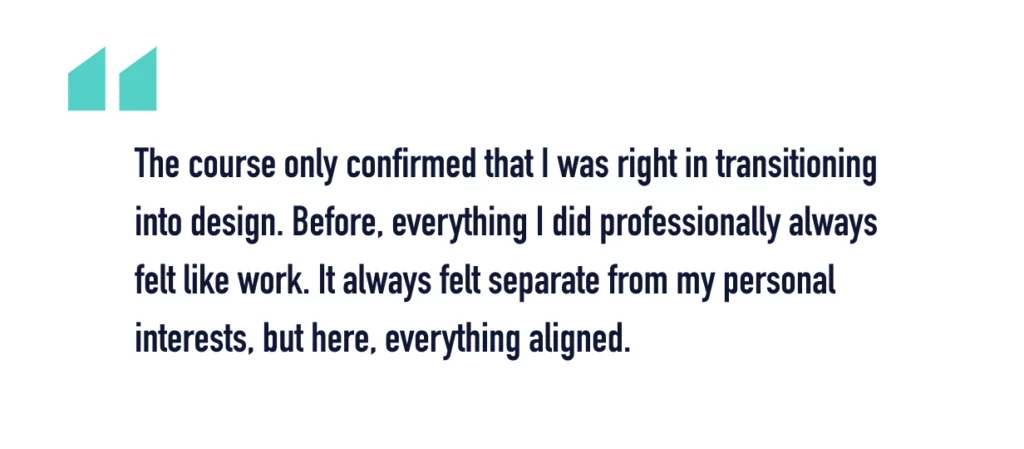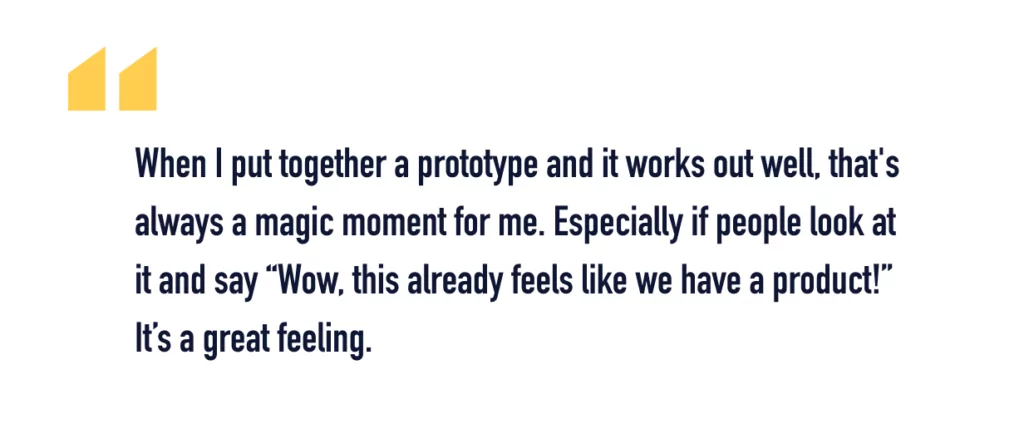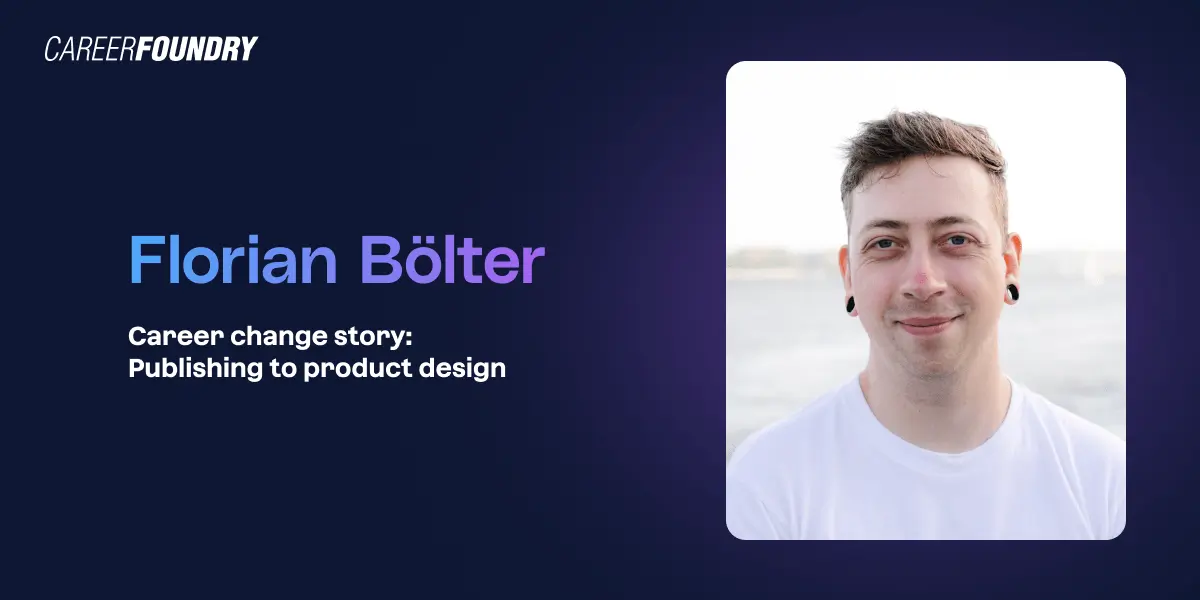Florian went from studying literature and working in publishing and software to landing a rewarding job as a product designer for a livestreaming platform. Here’s how he transformed his career in a matter of months.
From working in digital publishing, FinTech, and software solutions, Florian’s had a taste of many industries. He made a career switch and studied UI design with CareerFoundry. He’s now working as Senior Product Designer at AI-enabled contract collaboration tool, Juro.
But is product design hard to get into? And is it a good career? Here’s what Florian had to say about his journey into design and his new career.
Hi Florian! Thanks for speaking with me today. Can you tell me a bit about yourself and your background?
Hi Emily, thanks for having me. Well, my educational background is in literature actually. That was what I initially studied and I have a master’s degree in. However, I was always a very digital person and drawn to the design space—and to visual design in general—but I never considered it professionally because I always felt that I didn’t have the right skills.
What were you doing before you took the UI Design Program?
I worked in a publishing house after finishing my degree, where I did a lot of digital strategy. The basic task was establishing a workflow to transform the files for a print book to a digital publication. After that, I took a job as a product manager at a software company and that’s eventually what led me to UX/UI and CareerFoundry.
Before we get to your time at CareerFoundry, could you tell us more about the product manager role and your discovery of UX/UI design?
I knew what a product manager did but of course I had never done it myself. It turned out that this role was very different though because the company had no agile structures in place. There were developers but no designers so I had to learn a lot by myself.
As a product manager, I felt responsible for giving the developers a bit more perspective. I did some basic wireframes and user research to the extent that I could. This was when I came across UX and UI design for the first time, and I saw the need to introduce it into the process.
I learned that there is a huge benefit in actually getting to know what your users want and need and how they behave. No one at that company did that. I tried to establish some processes and learn about design myself.
That’s very proactive of you. What made you decide to change careers then? Did you have any idea how to become a product designer?
After a year in this role, I decided to draw a line under everything and take a look back at everything I had been doing. The design part really stood out and was really something that filled me with energy and passion. When I started researching how to re-train for a career in design, the algorithms of course brought CareerFoundry up!
What made you choose the CareerFoundry program?
I did some competitive research and I found that CareerFoundry was a well-established company with many successful alumni. It is also based in Germany—where I live—but with an international focus and a great emphasis on mentoring.
I also found out that if I wasn’t working, I could be eligible for some funding from the government to take the course, which was a very welcome discovery. I also liked that CareerFoundry’s program was focused on actual work tasks and reading in between, rather than video tutorials and live lessons. Of course there are different types of learners, but for my learning style, CareerFoundry’s approach seemed ideal.
And how was your experience during the CareerFoundry UI Design Program?
I did the course very quickly, in less than 4 months. I am a fast learner and generally very energetic when I approach something which I have a passion for.

What was your relationship like with your mentor?
I had a very nice mentor, Anna, who really went the extra mile for me. Even though I made the decision of what I wanted to do next independently—and chose to quit my product manager job—it still felt like a big step. It’s important to feel supported in your career change and it was great to get that support from Anna.
I’m pleased to hear it. What happened after you graduated? Is product design hard to get into?
I took on lots of projects after I completed the program because I felt that I needed to stay active and I wanted to boost my design experience even further. I stayed involved with CareerFoundry’s Slack community to help other people who are just starting out, and to stay engaged in a creative space because design is very community driven.
I started a local UX/UI design group here in Hanover. There are not so many people here in the design space but I thought that maybe I could bring us together. It’s called HUG, which stands for Hanover UX/UI Group. We want to get the word out about what design can actually do for your product and, of course, engage with other designers.
Florian isn’t the only graduate organizing meetups in his local area. Check out this story from Juliana, who set up a UX meetup in Halifax, Canada.
However, the biggest thing for me professionally was a remote internship as a UX/UI designer I secured with a start-up in the UK called Tred. They have an app that connects to your bank account and calculates your carbon footprint. It gives you a really personalized idea about your impact on the environment.
I wanted to work on a consumer-facing product that actually had an impact so this was ideal. I stayed with them for three months. It was a really great time because I got to do a lot of work.
Early stage start-ups give you the ability to shape a product—even as an intern—and I learned so much in those three months. It was a lot of self-starting learning and self-starting work, but the experience was really invaluable. That was probably one of the biggest contributing factors to landing my job as a product designer at Heygo.
It definitely sounds like valuable experience. Tell me about the hiring process and landing the job with Heygo.
I just contacted the recruiter from the job description I saw. It was an agency and the company was not named at that point. She gave me a call immediately after. I remember it was a Friday when we had a chat, and the next thing I knew I had the first interview with the company. From there on, I had two other interviews, including a task, and on Tuesday evening I had an offer! So three days in total—it was absolutely brilliant.
All the work that I did after completing the CareerFoundry program had paid off; the HUG group, the internship with Tred, and some other smaller projects all boosted my CV and my portfolio. People could see that I put in work and I learned a lot in a very short space of time.
Congratulations! It’s great to hear your hard work paid off. What advice would you give to other CareerFoundry graduates in the job-searching phase?
Stay active after the course. Focus on getting hired and just put out applications all the time. Take on a project, look for an internship, look for voluntary opportunities—which I also did by the way, with an organization called Mutual Aid.
Great advice. You’re started working at Heygo, can you tell us more about the product and your role?
Heygo was a platform which livestreams guided tours all around the world, usually a 45-60 minute tour that customers can take for free, and you can leave a tip for the guide at the end. You can chat with the guide on the tour, you can ask questions and also chat with other travelers.
In terms of the product team, we work in multiple squads. For example, one squad working for the actual users that view the content on the platform, another for the guides themselves (who are also a type of user for us). I work across all the squads though. For a while, I was the only designer but I was recently joined by a Head of Design as well as another product designer.
What is a typical day like for you as a digital product designer?
I do everything from discovery to research, and then actually designing and iterating, talking with stakeholders, such as the CPO, the product manager, and sometimes the founders as well, depending on what I’m designing.
I work very closely with the developers and the product manager. We have regular catch-ups and then I’ll iterate further based on those discussions. With small things, sometimes all of that can happen in a day. Sometimes it takes a week or so for the bigger tasks.
It’s really fast-paced. I have days where the product manager comes in with two very small—but spontaneous—tickets, so I have to put down my work and start on something else. In a start-up at this stage, you really have to be flexible.
Recommended viewing: A Day in the Life of a Product Designer
So far your whole career with design has been remote. How has that been?
When I started this journey, I knew I wanted to work remotely because I needed the flexibility with my family, but it was also a very conscious choice because in Hanover there aren’t many opportunities in design.
Remote work requires a lot of self-management. For someone who really enjoys being managed by someone else it might not be for them, but I like the flexibility remote work provides.
The social aspect is of course something else. Many of us have Zoom fatigue these days, however, I don’t, personally. I have to say I’m always happy when I see faces on the screen. We have virtual social nights at Heygo and regular one-on-one chats where we can just casually talk for half an hour with another colleague. That really helps.

My main driver for working remotely though was that I wanted to work in a company where people come from different backgrounds, countries, and cultures. For me, that makes not only a product, but also a workplace culture, better. That was something I always wanted to do; work for an international company from my home.
Looking to your future career, are there any industries or sectors that you’d like to help shape as a designer?
Regarding livestreams, Twitch is obviously huge and YouTube Live is growing, but I think structured content via livestreams is still relatively untouched. I think Heygo does well in that regard (with the virtual tours). Right now I’m filling that gap and I want to shape the livestream space, so it’s definitely something I intend to stay in.
With my internship at Tred, I got to work in the FinTech industry which was very interesting; I would love to work in FinTech again one day. I also have a big love for education, so if ever a suitable EdTech opportunity comes around, I would be down for that as well.
But as you might already tell, I don’t have very strong preferences! I like to learn a lot so I’m very open to many fields. I just want to work on a product that has a real impact on people’s lives. Whatever problem that is, I will help shape.
Is product design a good career choice?
I love everything about it really. I love creating in Figma, putting together my components and seeing my work come alive. But also the research; talking with people and getting their insights and another angle is just lovely.

What would you say makes for a good designer?
Being open to feedback. You need to be able to listen to people and be open to feedback, and be able to also voice your feedback, too. For example, when working with developers, you need to be able to say, “I’m sorry, but there’s something wrong with that button. You didn’t do that right, and we need to go over that.”
One final question from me: if you could give any advice to someone who’s wondering how to become a product designer without any design background what would it be?
Before I had my first touchpoints with UX/UI and product design, I thought that all design was based on graphic design, but that’s really not the case. Design is a combination of everything. It’s not only a job where I sit at home at my desk and draw stuff, it is also a people job.
If you are a people-person, the skillset doesn’t really matter so much. I enjoy the holistic nature and being involved in the whole process from discovery right to hand-off, but it is not about skill. For example, I’m not very good visually and I’m not good with colors, but it doesn’t matter. These are things you can learn.
I wouldn’t go to the extent of saying everyone can be a designer, but everyone who wants to be a designer can be a designer, if they put in the work.
Aside from that, take a short course. I took one with CareerFoundry which was really good. All the people I have recommended CareerFoundry to say it really helped them to make a decision if they want to do UX or UI.
Thank you Florian! You’re clearly so passionate and hard-working and it’s great to hear that you really enjoy what you’re doing.
Feeling inspired to transform your career like Florian did? Hopefully, now you’ve got a good idea of how to become a product designer!
You can get a taster of UI design with CareerFoundry’s practical, free, introductory short course. And, if you’d like some help figuring out your options for a career change, we can recommend speaking with one of our program advisors.
